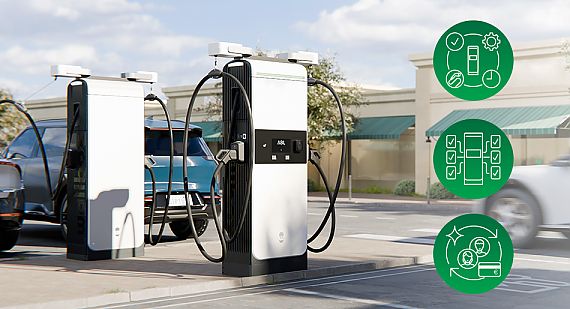
How do I charge my electric car?
Tips and tricks for beginners and those interested
At home at your own charging station, at work or in a public car park: the charging options for electric cars are becoming increasingly diverse. If you've only recently started driving electrically, it can sometimes be difficult to keep track of the "charging jungle": Does charging at a public charging station work in the same way as at your own wallbox? The key message first: charging is basically uncomplicated. With our overview of the different ways to start a charging process, it's child's play for you at any charging station.
How to start a charging process – an overview

The decisive factor is where you charge your electric car. If you charge your car privately at home at an ABL charging station, you have several options for starting the charging process: The simplest option is to start the charging process by plugging in the charging cable (1). After successful communication with the electric car, the charging process starts automatically. If the function is supported by the charging station, it is also possible to start and stop the charging process manually via the app (2). With a charging station that is equipped with a RFID function, the charging process can be enabled either via an RFID card (3) or an RFID keyfob (4). This makes sense if the charging station is freely accessible and should not be used by unauthorised persons. The RFID function can also be used in a backend-capable charging station for billing purposes, e. g. for charging a company car. Authentication via RFID makes it possible to track who has charged how much at what time.
If you charge in the (semi-)public area, you have to pay for the charging process. A distinction is made between contract-based and direct or ad-hoc charging. If you frequently charge at public charging stations, it makes sense to choose a charging tariff and conclude a charging contract with the selected provider. Depending on the provider, the charging process at the public charging station can then usually be started using an RFID charging card (6), an app (2) or by inserting the charging plug (1) via the Plug and Charge (PnC) communication standard. Ad-hoc charging, i. e. charging and direct payment without a contract-based charging tariff, is currently still mainly possible by scanning a QR code (5). This is attached directly to the charging station and, after scanning with a smartphone, leads to a website where the preferred payment method (e. g. credit card) can be stored. After verification, the charging process starts.
The good news: charging and paying at public charging stations will soon be even easier
E-car drivers can breathe a sigh of relief: since the AFIR came into force on 13 April 2024, ad-hoc charging at fast chargers with a charging capacity of 50 kW or more has been even easier, as charging processes can be activated and paid for directly and contactlessly by debit and credit card (7). In Germany, the EU regulation is being transposed into national law as part of the Charging Station Ordinance. The advantage is that payment is even more straightforward not only in Germany, but throughout the EU.



